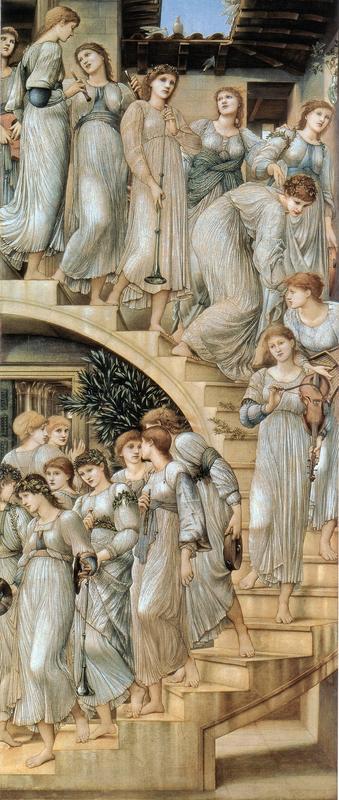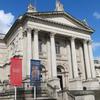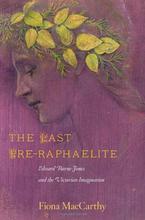More about The Golden Stairs
- All
- Info
- Shop

Contributor
The Golden Stairs by Sir Edward Coley Burne-Jones is supposed to put you in the mood. (Or at least, a mood.)
No one really knows who exactly these women are supposed to be or if they are supposed to be anyone at all. This lack of understanding is a little frustrating, which is exactly the way that Burne-Jones wanted it. He must have known and relished the fact that people would be debating his work 138 years after it was completed, the smug bastard. He was, as his biographer described, “maddeningly evasive.”
This lack of narrative wasn’t rare in Burne-Jones’ work. He was more concerned with conveying a "mood" rather than a story. This idea was way more of an Aesthetic Movement thing than a Pre-Raphaelite Brotherhood thing, so this painting actually shows a transition between the two periods. The Aesthetic Movement was a style that "demanded beauty, but not a direct link to a source.” The artists of the Aesthetic Movement also loooved the idea that music could make you feel a certain way without any attached narrative, which is why each woman is holding a different musical instrument. The same notion propelled the late 90s/early aughts emo phase. The main idea in this painting as understood by the critic Walter Pater is that "all art constantly aspires to the condition of music.”
The faces that you see in this painting may look painfully alike but they were actually modeled after several of Burne-Jones’ friends and family. Second from the top left is the artist’s daughter, Margaret. At the bottom of the stairs, holding a cymbal is a women that Burne-Jones was once in love with, Frances Graham. She also happened to be the daughter of one of the artist’s closest friends and patrons, which couldn’t have been good for business. Behind Francis is Mary Gladstone, whose father became Prime Minister the day before this painting was exhibited for the first time. The woman halfway down the stairs holding a violin is May Morris, the daughter of Burne-Jones’ longtime friend, William Morris. There are a few more friends who are rumored to have been thrown in, but their whereabouts are undetermined.
This painting has been categorized as Burne-Jones' very best work, but my favorite staircase painting is still Nude descending a Staircase by Duchamp.
Sources
- Flanders, Judith. "The Last Pre-Raphaelite: Edward Burne-Jones And The Victorian Imagination By Fiona Maccarthy: Review." Telegraph.co.uk. Accessed September 21, 2018. https://www.telegraph.co.uk/culture/8747049/The-Last-Pre-Raphaelite-Edw…
- Jeffrey Easby, Rebecca. "Burne-Jones, The Golden Stairs." Khan Academy. Accessed September 21, 2018. https://www.khanacademy.org/humanities/becoming-modern/victorian-art-ar…
- "The Golden Stairs’, Sir Edward Coley Burne-Jones, Bt, 1880 | Tate." Tate. Accessed September 21, 2018. https://www.tate.org.uk/art/artworks/burne-jones-the-golden-stairs-n040…
- "The Mystery Of The Maidens On The Stairs | Christie's." Christies.com. Accesssed September 21, 2018. https://www.christies.com/features/Unseen-Burne-Jones-studies-for-The-G…
Featured Content
Here is what Wikipedia says about The Golden Stairs
The Golden Stairs is one of the best-known paintings by the Pre-Raphaelite artist Edward Burne-Jones. It began in 1876 and was exhibited at the Grosvenor Gallery in 1880.
Unlike many of Burne-Jones's works, The Golden Stairs is not based on a literary source. It has been called Symbolist, as it has no recognisable narrative, but rather sets a mood. It is a harmony of color in the tradition of the Aesthetic works of the 1860s and 1870s, as a group of young women carrying musical instruments descend a spiraling staircase, dressed in classically inspired robes in tones of white, shading to gold and silver. Critic F. G. Stephens wrote in The Athenaeum that the musicians "troop past like spirits in an enchanted dream ... whither they go, who they are, there is nothing to tell".
The Golden Stairs was one of many paintings Burne-Jones sketched out in 1872 following a trip to Italy. He began work on the canvas in 1876 and finished it in great haste in April 1880, just days before the Grosvenor Gallery exhibition was to open. Stephens found in the painting, echoes of the work of Piero della Francesca, whose frescoes Burne-Jones had seen and copied in 1871. The figures of the musicians were drawn from professional models, but the heads are young women of Burne-Jones's circle. Some identifications have been made as follows.
His daughter Margaret is fourth from top, holding a trumpet. Edith Gellibrand, known also by the stage name Edith Chester, has been considered as the model for seventh from top, seen stooping. May Morris, daughter of William Morris, is ninth from top, holding a violin. Frances Graham, later known as Lady Horner, daughter of William Graham, is bottom left, holding cymbals. Standing behind her on the stairs is Mary Gladstone, daughter of William Gladstone. Others include Laura Tennant, later known as Laura Lyttelton, and Mary Stuart-Wortley, later Lady Lovelace.
The central portion of the staircase is an error in foreshortening inasmuch as three of the "steps" appear to be vertical drops without anywhere to place one's feet.
The painting was purchased by Cyril Flower (1843–1907), later Lord Battersea, a politician and art patron, and was bequeathed by him to the Tate Gallery, where it remains.
Check out the full Wikipedia article about The Golden Stairs













